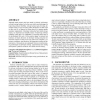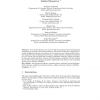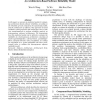SIGSOFT
2010
ACM
14 years 4 months ago
2010
ACM
Although much progress has been made in software verification, software testing remains by far the most widely used technique for improving software reliability. Among various typ...
JUCS
2002
14 years 6 months ago
2002
: Over the last 30 years or so many results have appeared on the descriptional complexity of machines with limited resources. Since these results have appeared in a variety of diff...
DICS
2006
14 years 8 months ago
2006
Achieving software reliability takes many complementary techniques, directed at the process or at the products. This survey summarizes some of the most fruitful ideas. 1 OVERVIEW ...
PRDC
2000
IEEE
14 years 10 months ago
2000
IEEE
Since the early 1970's a number of models have been proposed for estimating software reliability. However, the realism of many of the underlying assumptions and the applicabi...
COMPSAC
2004
IEEE
14 years 10 months ago
2004
IEEE
Software reliability is defined as the probability of failure-free software operation for a specified period of time in a specified environment. Over the past 30 years, many softw...
PRDC
1999
IEEE
14 years 10 months ago
1999
IEEE
In this paper we present an analytical model for estimating architecture-based software reliability, according to the reliability of each component, the operational profile, and t...
CPE
2000
Springer
14 years 10 months ago
2000
Springer
Abstract. Several tools have been developed for the estimation of software reliability. However, they are highly specialized in the approaches they implement and the particular pha...
COMPSAC
2002
IEEE
14 years 11 months ago
2002
IEEE
The method of choice of the software reliability models based on the analysis of assumptions and compatibility both input and output parameters is offered. This method is illustra...
ISSRE
2003
IEEE
14 years 11 months ago
2003
IEEE
Many architecture–based software reliability models were proposed in the past. Regardless of the accuracy of these models, if a considerable uncertainty exists in the estimates ...
EUROMICRO
2003
IEEE
14 years 11 months ago
2003
IEEE
: The approach of aggregating components into complex software systems is maturing with the rapid development of component technology. How to analyze software reliability from syst...



